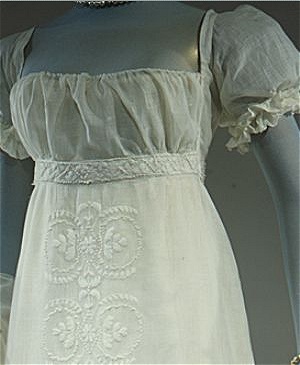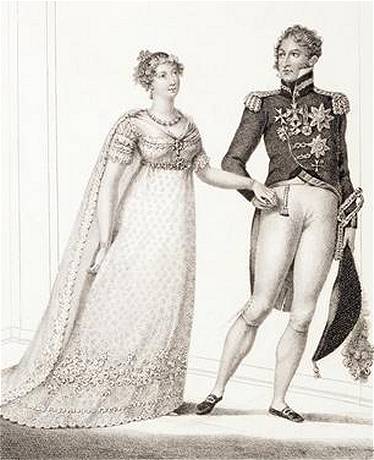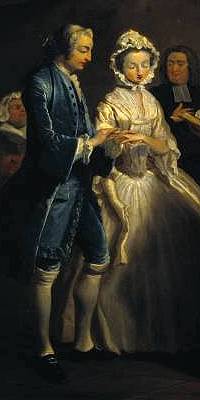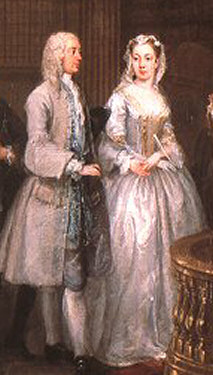|
Illustration:
4. French Evening Dress, ca. 1804–1805, The Metropolitan Museum of Art.
5. The wedding of George [IV] Prince of Wales and Princess Caroline Amelia Elizabeth of Brunswick-Wolfenbuttel at St James's Palace in London on April 8, 1795. After painting by Singleton
6. "Princess Charlotte of Wales and Prince Leopold of Cobourg returning from the Altar, after the Marriage Ceremony" on May 2 1816 Etching published in La Belle Assemblee of May 1816.
7. "Pamela is Married," Oil on canvas, ca. 1743-4. From a series of 12 paintings from Samuel Richardson's 'Pamela' by the English painter Joseph Highmore (1692-1780), now in the Tate Collection.
8. 'The Wedding of Stephen Beckingham and Mary Cox' painted by Hogarth 1729
9. Elizabeth Patterson Bonaparte ca. 1817. Painging by Francois Josephe Kinsoen, now owned by the Maryland Historical Society
10. 'Mariage de Napoléon Ier et de Marie-Louise. 2 avril 1810 ; Banquet du mariage de Napoléon et de Marie-Louise dans la salle de spectacle des Tuileries' (The marriage banquet of Napoleon I and Marie-Louise of Austria April 2, 1810). Detail of painting by Francesco Giuseppe Casanova (1727-1802), now at Musée National du Château Fontainebleau.
Notes on the text:
d: Evening Dress, ca. 1804–1805 French cotton. 96 ¾ in. (245.5 cm) long, measurecd from the middle of the back. Now in The Metropolitan Museum of Art.
Originally thought to have been Patterson's wedding dress, this formal gown dates from 1804, when this type of vertical white embroidery became fashionable. The very sheer cotton mull from which the dress is made was probably imported from India and already embroidered with the heavy white cotton thread in satin stitches and French knots. A chemise (underdress) and corset was normally worn underneat this near transparent garment. Only the very daring abandoning these articles of clothing for a brief period at the turn of the century.
e: Wether Anne's wedding dress was indeed white may well be a piece of popular lore; it's provenance unconfirmed after an exhaustive search.
f: Description from "George IV" by Alan Palmer, published 1972
g: "As we have been gratified with a sight of the wedding dresses of this amiable and illustrious female, a particular yet concise account of them cannot but be acceptable to our fair readers.
The Royal Bride, happy in obtaining him whom her heart had selected, and whom consenting friends approved, wore on her countenance that tranquil and chastened joy which a female so situated could not fail to experience. Her fine fair hair, elegantly yet simply arranged, owed more to its natural beautiful wave than to the art of the friseur; it was crowned with a most superb wreath of brilliants, forming rosebuds with their leaves.
Her dress was silver lamé on net, over a silver tissue slip, embroidered at the bottom with silver lamé in shells and flowers. Body and sleeves to correspond, elegantly trimmed with point Brussels lace. The manteau was of silver tissue lined with white satin, with a border of embroidery to answer that on the dress, and fastened in front with a splendid diamond ornament. Such was the bridal dress [...]
The jewellery of the royal bride is most superb; beside the wreath, are a diamond cestus, ear-rings, and an armlet of great value, with a superb set of pearls. The court dresses worn by the royal family and nobility on this occasion were particularly splendid; we are sorry our limits will not allow us to enter into particulars, but we cannot forbear noticing the singular taste and elegance, displayed in the superb lamé dress, so beautifully wrought with silver lilies, of the Marchioness of Cholmondeley; we have never before witnessed so charming a combination of classical taste, splendour, and touching simplicity.'
Having a desire to see Royalty I attended the Chapel Royal, St. James' Palace, to see the Princess Charlotte, probably the future Queen of England [...] The Princess came in attended by several lords and ladies, and took her seat in the gallery opposite to where I stood. She has a pretty face and eyes, with the buxomness of a country lass. Her dress was purple pelisse edged with white, with a French fashioned bonnet and a wreath around it." Text originally published in the May 1816 issue of The Lady's Magazine
h: Published 1830-1885 in United States, first as The Lady’s Book, named later changed to Godey’s Lady’s Book after its founder Louis Antoine Godey. 1836 merged with the American Ladies' Magazine. Considered as the first successful American women's magazine. The magazine, which featured articles by famous authors and colored plates of the latest fashions, attained a circulation of 150,000 by 1858 and was considered an arbiter of morals and taste. Digital text available from Accessible Archive Inc.
i: 'The Wedding of Stephen Beckingham and Mary Cox', 1729 by William Hogarth (1697–1764) now in the collection of The Metropolitan Museum of Art, New York.
The inscription informs us that Hogarth's subject is the wedding, on June 9, 1729, of Stephen Beckingham, a lawyer. Beckingham's marriage to Mary Cox took place at St. Benet's, Paul's Warf, but the interior depicted, perhaps by a hand other than Hogarth's, instead resembles that of James Gibbs's new Church of Saint Martin-in-the-Fields, Trafalgar Square. The church was consecrated in 1726 and we are thus afforded an approximate view of a London church in the most up-to-date, early Georgian style.
j: Samuel Richardson's (1689-1761) "Pamela, or Virtue Rewarded" published 1740, was a hotly contest book at the time and still considered a landmark in the development of novel writing. Project Gutenberg offers the full etext of Pamela as a free download.
k: On December 24, 1803, Jerome Bonaparte (1784-1860), brother of Napoleon, wed Elizabeth Patterson (1785-1879) of Baltimore. The beautiful and fashionable young American was married in a dress of muslin and lace that, according to a contemporary, "would fit easily into a gentleman's pocket." Even though Elizabeth and Jerome had a son, Jerome Napoleon Bonaparte (1805-1870), Napoleon had the marriage annulled in 1805. In 1807 Jerome was made the king of Westphalia and married the princess of Wurttemberg.
l: Wedding dress depicted in a miniature by Jean-Baptiste Isabey (1767-1855)
m: A similar remark was supposedly made about Elizabeth Patterson's dress.
n: Jane Austen's niece Anna married Benjamin Lefroy at Steventon on November 8, 1814, in "a dress of fine white muslin, and over it a soft silk shawl, white shot with primrose [yellow], with embossed white-satin flowers, and very handsome fringe, and on her head a small cap to match, trimmed with lace." from "Reminiscences" of Caroline Austen. This book is published by Jane Austen Society and originally written in 1870 by Jane’s niece Caroline Mary Craven Austen, 1805 – 1880. Caroline provides some wonderful recollections and childhood memories about her Aunt. This is an interesting read, showing the Austens as they move through the years from rural Regency Hampshire, into a thoroughly Victorian era, and how the people and places Jane knew and loved changed with the times. |






